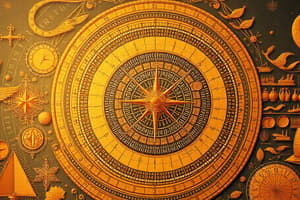Podcast
Questions and Answers
Як визначається швидкість за формулою?
Як визначається швидкість за формулою?
- Додаванням шляху і швидкості
- Діленням відстані на час подорожі (correct)
- Множенням часу на шлях
- Множенням відстані на швидкість руху
Як впливає погода на стратегічні рішення гонщиків у Формулі-1?
Як впливає погода на стратегічні рішення гонщиків у Формулі-1?
- Не впливає на стратегію гонщиків
- Може змінювати їхню швидкість і рішення під час гонки (correct)
- Робить гонку більш передбачуваною
- Збільшує їх швидкість під час гонки
Що враховують льотчики та навігатори при розрахунку часу прибуття на польоти?
Що враховують льотчики та навігатори при розрахунку часу прибуття на польоти?
- Висоту польоту
- Швидкість та напрям вітру (correct)
- Температуру повітря
- Довжину польоту
Як називається спотворення часу через взаємний рух астрономічних об'єктів?
Як називається спотворення часу через взаємний рух астрономічних об'єктів?
Яким методом NASA визначала точний момент, коли астронавти приземлилися на Місяць?
Яким методом NASA визначала точний момент, коли астронавти приземлилися на Місяць?
Як визначається переміщення об'єкта?
Як визначається переміщення об'єкта?
Як вираховується величина руху за формулою?
Як вираховується величина руху за формулою?
Як можна розрахувати час руху об'єкта, якщо відома величина переміщення та швидкість?
Як можна розрахувати час руху об'єкта, якщо відома величина переміщення та швидкість?
Що таке переміщення об'єкта?
Що таке переміщення об'єкта?
Як можна знайти час руху при відомих величини швидкості та часопроводу руху?
Як можна знайти час руху при відомих величини швидкості та часопроводу руху?
Flashcards are hidden until you start studying
Study Notes
Time is calculated by multiplying speed by time using the formula: Time = Distance / Speed. This formula allows us to determine how long it takes to travel between two points given their distance and the speed of the object moving between them.
Speed, on the other hand, is calculated by dividing the total distance traveled by the duration of the trip. For example, if you drive from New York to Los Angeles and cover the distance in five hours, your average speed during the trip would be 96 miles per hour (assuming a straight line distance of approximately 2488 miles).
In Formula One racing, for instance, drivers have to calculate fuel consumption and tire wear rates against a pit stop time. They must also factor in possible weather changes which may affect their speed and strategy decisions during races. Similarly, pilots and navigators need to consider various factors like wind direction and speed when calculating their arrival times for flights.
Moreover, time dilation due to relative motion can play a role in spacecraft navigation. In 1971, NASA's Apollo 14 mission used Doppler radar technique to measure the spacecraft's velocity vector and compare it with Earth's position data to compute time difference. By comparing clocks onboard the spacecraft and those on Earth, scientists were able to determine the exact moment astronauts landed on the moon.
It's important to note that while these calculations involve basic arithmetic principles, they often require complex algorithms and high-precision instruments to execute effectively. Nonetheless, understanding these foundational concepts lays the groundwork for mastering more advanced mathematical applications related to physics, engineering, and computer science.
Studying That Suits You
Use AI to generate personalized quizzes and flashcards to suit your learning preferences.



